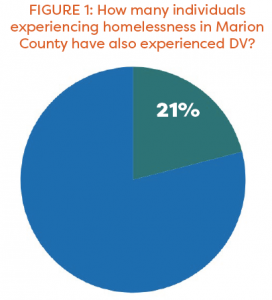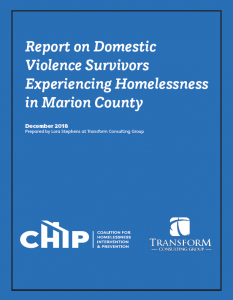When you’re using data to make decisions, are you also taking time to break down data to learn more? Perhaps you are struggling to understand the needs of different parts of the population you serve. Maybe you’re noticing different outcomes in different groups but don’t know why. When you break down data, you can see what’s hidden within your overall results.
One important reason to break down data is to help your clients who are experiencing multiple adverse events. Our team at Transform Consulting Group worked with Coalition for Homelessness Intervention and Prevention (CHIP) to understand the challenges of people experiencing both homelessness and domestic violence. We took a close look at their data. Then we came up with recommendations on how to best meet the needs of this population.
A significant portion of individuals who are homeless have also experienced domestic violence. In Marion County, 21% of individuals in the Homelessness Management Information System (HMIS) had lived in households with reported domestic violence (DV). 
Based on national best practices and local data, CHIP and its partners identified potential system and policy improvements. They gathered feedback from domestic violence survivors experiencing homelessness via surveys and focus groups.
The data and research revealed the need for targeted public policy and legislative protections for this population. When domestic violence survivors leave their relationships, they face economic hardships that put them at risk for homelessness. One policy solution allows survivors to remain in their rental home after the perpetrator is removed from the lease.
Breaking down the data led to this policy recommendation that is specific to domestic violence survivors. This policy change goes beyond what’s relevant for all individuals experiencing homelessness.
In other instances, breaking down data can be particularly helpful to ensure you meet the needs of the most marginalized people. Are children from high-income families able to access your programming more easily than other children? Are your participants of color seeing the same gains as your white participants? Do those in rural areas achieve the same positive results as urban communities? Looking at data in this way can help you focus on equity for your vulnerable populations.
Researching national best practices revealed that domestic violence survivors, in particular, benefit from meeting with advocates in locations other than their office. Survivors face transportation and other logistical barriers. This can mean it’s much easier if an advocate comes to their home or neighborhood.
There are more details on all the data and findings in the Report on Domestic Violence Survivors Experiencing Homelessness in Marion County that Transform Consulting Group prepared for CHIP. 
No matter what your organization’s mission is, breaking down data can help you learn more about different segments of the population you’re serving. Do you see better outcomes when participants have been in your program for more than six months? Is your curriculum more effective for younger children?
In addition to breaking down your data, check out our other blogs on making sure you’re data literate and putting data into context!
If you aren’t using data to look at segments of the population you serve, then you might be missing what is (or isn’t) working well in your program. Let us know if you need help with data analysis or program evaluation!

